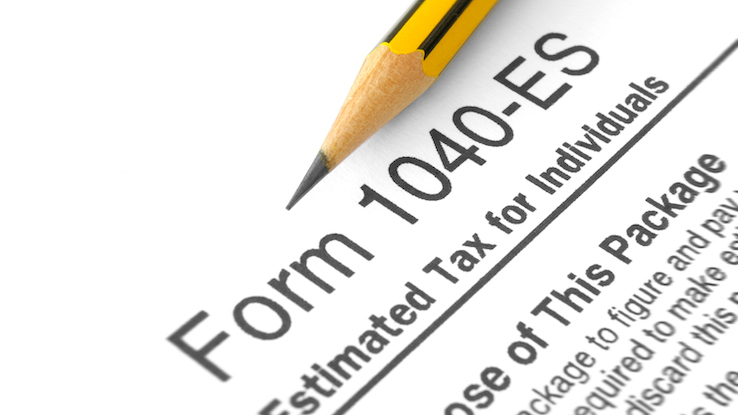
If you make money from a job that doesn’t withhold income tax deductions, you should get familiar with Form 1040-ES and the easy-to-use vouchers that help you make quarterly tax payments. The IRS offers 1040-ES payment vouchers to streamline this process, which you’ll need to mail in several times a year.
What Is a 1040-ES Form Payment Voucher?
Income taxes are essentially a yearly reconciliation between yourself and the government. The percentage of your income that you need to pay as taxes increases the more you earn. At the end of the year, you pay the government if you haven’t paid enough, and the government pays you if you’ve paid too much into income taxes.
If you’re solely an employee at a job that withholds income tax deductions, you do not need to worry about calculating your tax rate or paying income taxes throughout the year. Rather, your job automatically deducts money for taxes based on your selections on your W-4 and any applicable state tax forms.
If you are self-employed or earn income outside of a job that makes tax deductions, you need to file taxes quarterly and make estimated tax payments. When you make these estimated payments, you send your payment and a payment voucher found at the bottom of Form 1040-ES. These vouchers help the IRS attach the payment to you and keep track of the payments you make each financial quarter.
Although there are some exceptions, the IRS prefers to be paid throughout the year as you earn income rather than waiting until you file your tax return. This will help you at tax time because you’ll either get a refund from the IRS or have a much smaller tax bill than you would if you did not pay any taxes throughout the year.
Who Needs to Use a 1040-ES?
The need to use 1040-ES vouchers depends on two factors. First, you need to qualify by the way you earn income. Second, you qualify to use 1040-ES vouchers by the amount of taxes you expect to have to pay at the end of the year.
You meet the first qualification if you make any income for which no income tax withholdings are deducted. This can include an online side hustle or self-employment that is your main source of income. You may work a regular job and also earn income from a rental property, alimony or investments.
The second qualification involves the amount of taxes that you expect to pay at the end of the year. You only need Form 1040-ES if you expect to owe $1,000 or more in federal taxes for that income that does not have regular income tax deductions. For example, if you only get an annual alimony check of $500, you can be certain that you will not owe more than $1,000 in federal taxes for that income.
To be clear, you should not view using form 1040-ES vouchers to make quarterly tax payments as optional if you are someone who is obligated to file quarterly taxes. There is some leeway for people who make incorrect estimates, but failing to file quarterly taxes has consequences.
For example, a woman who sells trading cards for a living may not expect to need to pay more than $1,000 in income taxes because of either making little income or having her income significantly reduced by qualifying business expenses. Suppose she does end up paying more than $1,000 in federal income taxes. If this is unusual for her, she can show that she acted in good faith by not filing quarterly taxes.
On the other hand, another woman who makes $100,000 per year from the salary she earns in her business and files taxes as an S-corporation would have a harder time proving that she legitimately expected not to pay more than $1,000 per year in taxes.
If the IRS determines that you should have been paying quarterly taxes and you failed to, the organization can charge you late fees for each quarter, even if you file your annual tax return on time. For this reason, many self-employed people err on the side of caution and file quarterly taxes even when they are not sure they have to.
How to Fill Out a 1040-ES Form Payment Voucher
Form 1040-ES is a larger form that assists you in calculating how much you need to pay in annual taxes. The vouchers are located on the last few pages of the form. There are technically four due dates throughout the year to pay the estimated taxes for the four fiscal quarters of the year. These dates fall on the fifteenth of the month following the end of the fiscal quarter (April, June, September and January), but the date is adjusted to the next earliest day if it falls on a weekend or a federal holiday.
Although there are four financial quarters, only three payment vouchers are located on the form. Payment for the fourth financial quarter happens in the following year, and many taxpayers opt to go ahead and file their yearly taxes by that due date, which removes the need to make a fourth estimated payment.
On each voucher, you include your full name, social security number or EIN and mailing address. If applicable, you also will need to include your spouse’s name and Social Security number. There is a field at the top of the 1040-ES voucher to write the amount of money that you are submitting as an estimated tax payment.Finally, you enclose both the voucher and a check or money order payable to the United States Treasury to the correct IRS field office address for your region. If you file taxes electronically or wish to make your quarterly payments online, you can complete your 1040-ES voucher and make your payment through the EFTPS. Some tax software also has a function that allows you to virtually complete the form and make the payment.





